Honda HSS724A User Manual
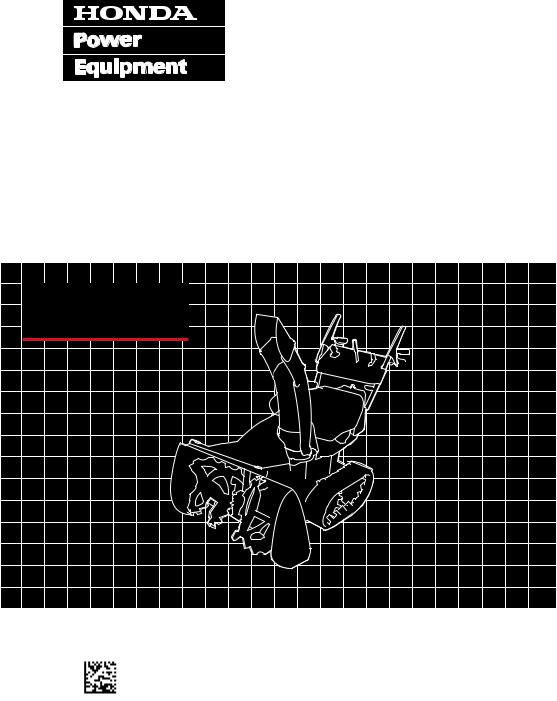
Owner’s Manual
SNOW BLOWER
HSS724A
Click to Save As |
00X31V45 A040 |

INTRODUCTION
Congratulations on your selection of a Honda snow blower! We are certain you will be pleased with your purchase of one of the finest snow blowers on the market.
We want to help you get the best results from your new snow blower and to operate it safely. This manual contains the information on how to do that; please read it carefully.
As you read this manual, you will find information preceded by a  symbol. That information is intended to help you avoid damage
symbol. That information is intended to help you avoid damage
to your snow blower, other property, or the environment.
We suggest you read the warranty policy to fully understand its coverage and your responsibilities of ownership. The warranty policy is located in the back of this manual.
When your snow blower needs scheduled maintenance, keep in mind that your Honda servicing dealer is specially trained in servicing Honda snow blowers. Your Honda servicing dealer is dedicated to your satisfaction and will be pleased to answer your questions and concerns.
Best Wishes,
American Honda Motor Co., Inc.
1

INTRODUCTION
A FEW WORDS ABOUT SAFETY
Your safety and the safety of others are very important. And using this snowblower safely is an important responsibility.
To help you make informed decisions about safety, we have provided operating procedures and other information on labels and in this manual. This information alerts you to potential hazards that could hurt you or others.
Of course, it is not practical or possible to warn you about all the hazards associated with operating or maintaining a snow blower. You must use your own good judgment.
You will find important safety information in a variety of forms, including:
•Safety Labels — on the snow blower.
•Safety Messages — preceded by a safety alert symbol  and one of three signal words, DANGER, WARNING, or CAUTION.
and one of three signal words, DANGER, WARNING, or CAUTION.
These signal words mean:
You WILL be KILLED or SERIOUSLY HURT if 


 you don’t follow instructions.
you don’t follow instructions.
You CAN be KILLED or SERIOUSLY HURT if you don’t follow instructions.
 You CAN be HURT if you don’t follow
You CAN be HURT if you don’t follow 



 instructions.
instructions.
•Safety Headings — such as IMPORTANT SAFETY INFORMATION.
•Safety Section — such as SNOW BLOWER SAFETY.
•Instructions — how to use this snow blower correctly and safely.
This entire book is filled with important safety information — please read it carefully.
2
CONTENTS |
|
SNOW BLOWER SAFETY ............................................................ |
5 |
IMPORTANT SAFETY INFORMATION ........................................ |
5 |
SAFETY LABEL LOCATIONS..................................................... |
8 |
INITIAL USE INSTRUCTIONS ....................................................... |
9 |
CONTROLS & FEATURES .......................................................... |
12 |
COMPONENT & CONTROL LOCATIONS................................... |
12 |
CONTROLS .......................................................................... |
12 |
Fuel Valve Lever ................................................................ |
15 |
Engine Switch.................................................................... |
14 |
Starter Grip ....................................................................... |
15 |
Throttle Lever .................................................................... |
16 |
Shift Lever ........................................................................ |
17 |
Chute Joystick Control ....................................................... |
17 |
Drive Clutch Lever and Auger Clutch Lever............................ |
18 |
Steering Controls ............................................................... |
19 |
FEATURES ........................................................................... |
22 |
Snow Clearing Bar.............................................................. |
22 |
BEFORE OPERATION ................................................................ |
23 |
ARE YOU READY TO GET STARTED?...................................... |
23 |
IS YOUR SNOWBLOWER READY TO GO? ................................ |
23 |
Check the General Condition of the Snowblower.................... |
24 |
Check the Engine ............................................................... |
24 |
CHECK YOUR WORK AREA.................................................... |
25 |
OPERATION............................................................................. |
26 |
SNOWBLOWING PRECAUTIONS ............................................. |
26 |
STARTING THE ENGINE ......................................................... |
27 |
STOPPING THE ENGINE ......................................................... |
30 |
CLEARING SNOW ................................................................. |
33 |
SNOW-CLEARING TIPS .......................................................... |
35 |
REMOVING OBSTRUCTIONS .................................................. |
36 |
SERVICING YOUR SNOWBLOWER.............................................. |
37 |
THE IMPORTANCE OF MAINTENANCE .................................... |
37 |
MAINTENANCE SAFETY ........................................................ |
37 |
TOOL KIT............................................................................. |
39 |
MAINTENANCE SCHEDULE .................................................... |
40 |
REFUELING........................................................................... |
42 |
FUEL RECOMMENDATIONS.................................................... |
43 |
3

CONTENTS |
|
SERVICING YOUR SNOWBLOWER (continued) |
|
ENGINE OIL LEVEL CHECK ..................................................... |
44 |
ENGINE OIL CHANGE ............................................................ |
45 |
ENGINE OIL RECOMMENDATIONS .......................................... |
46 |
SPARK PLUG SERVICE........................................................... |
47 |
TRACK ADJUSTMENT ........................................................... |
49 |
TIRE INSPECTION.................................................................. |
50 |
AUGER AND BLOWER INSPECTION......................................... |
50 |
SHEAR BOLT REPLACEMENT PROCEDURE............................... |
51 |
SKID SHOES AND SCRAPER .................................................. |
52 |
STORAGE................................................................................ |
54 |
STORAGE PREPARATION....................................................... |
54 |
Cleaning............................................................................ |
54 |
Fuel.................................................................................. |
55 |
Engine Oil.......................................................................... |
58 |
Tires................................................................................. |
58 |
STORAGE PRECAUTIONS ...................................................... |
62 |
REMOVAL FROM STORAGE ................................................... |
62 |
TRANSPORTING ...................................................................... |
63 |
BEFORE LOADING ................................................................. |
63 |
LOADING ............................................................................. |
64 |
TAKING CARE OF UNEXPECTED PROBLEMS ............................... |
66 |
ENGINE PROBLEMS ............................................................... |
66 |
DRIVE PROBLEMS................................................................. |
67 |
SNOWBLOWER PROBLEMS .................................................... |
67 |
TECHNICAL INFORMATION ....................................................... |
69 |
Serial Number Locations...................................................... |
69 |
Carburetor Modification for High Altitude Operation................ |
70 |
Emission Control System Information.................................... |
71 |
Air Index ........................................................................... |
73 |
Specifications .................................................................... |
74 |
CONSUMER INFORMATION....................................................... |
75 |
Dealer Locator Information .................................................. |
75 |
Honda Publications............................................................. |
75 |
Customer Service Information.............................................. |
76 |
DISTRIBUTOR WARRANTY........................................................ |
78 |
EMISSION WARRANTY............................................................. |
80 |
4
SNOW BLOWER SAFETY
IMPORTANT SAFETY INFORMATION
Honda snow blowers are designed to clear snow from driveways and walkways. Other uses can result in injury to the operator or damage to the snow blower and other property.
Most injuries or property damage with snow blowers can be prevented if you follow all instructions in this manual and on the snow blower. The most common hazards, are discussed below, along with the best way to protect yourself and others.
Avoid Rotating Impeller and Auger
Hand contact with the rotating impeller inside the discharge chute is the most common cause of injury associated with snow blowers. The snow blower auger can also cause serious injury. Keep away from the impeller and auger whenever the engine is running. If you need to work around the snow blower to clear snow for any reason, always shut off the engine. If the snow discharge chute becomes clogged, stop the engine and disconnect the spark plug cap. Use the snow clearing bar or a wooden stick to remove the obstructions. Never put your hand into the snow discharge chute while the engine is running; serious personal injury could result.
Clear Operation Area
The snow blower can throw rocks and other objects with enough force to cause serious injury. Before operating the snow blower, carefully inspect the area and remove any visible stones, sticks, news papers, nails, pieces of wire, and other loose objects. Never use the snow blower to clear snow from a gravel road or driveway, as rocks may be picked up and ejected. They may cause injury to bystanders.
5

SNOW BLOWER SAFETY
Keep Shields in Place
Guards and shields are designed to protect you from being hit by thrown objects and to keep you from touching hot engine parts and moving components. For your safety and the safety of others, keep all shields in place when the engine is running.
Adjust the snow discharge chute to avoid hitting the operator, bystanders, windows, and other objects with ejected snow. Stay clear of the snow discharge chute while the engine is running.
Children and pets must be kept away from the area of operation to avoid injury from flying debris and contact with the snow blower.
Refuel with Care
Gasoline is extremely flammable, and gasoline vapor can explode. Allow the engine to cool if the snow blower has been in operation. Refuel only outdoors in a well-ventilated area with the engine OFF. Do not overfill the fuel tank. Never smoke near gasoline, and keep other flames and sparks away. Always store gasoline in an approved container. Make sure that any spilled fuel has been wiped up before starting the engine.
Turn Engine OFF When Not Operating the Snow blower
If you need to leave the snow blower for any reason, even just to inspect the area ahead, always turn the engine off.
Operation on Slopes
Do not use the snow blower on a slope greater than 20 degrees.
To avoid overturning, be careful when changing the direction of the snow blower while operating it on a slope. Do not use the snow blower to remove snow from angled roof tops. The snow blower may overturn on steep slopes if left unattended, causing injury to the operator or bystanders.
6

SNOW BLOWER SAFETY
Operating Conditions
Do not use the snow blower when visibility is poor. Under conditions of poor visibility, there is a greater risk of striking an obstacle or causing injury. Adjust the snow discharge chute to avoid hitting bystanders or vehicles.
Stay clear of the snow discharge chute while the engine is running and be aware that loose clothing can get drawn into the moving parts.
Operating Near Roads
Always watch for vehicle traffic when operating the snow blower near roads and driveways.
Operator Responsibility
Know how to stop the snow blower quickly in case of emergency. Understand the use of all snow blower controls.
Never permit anyone to operate the snow blower without proper instruction. Do not let children operate the snow blower. If people or pets suddenly appear in front of the snow blower while it is in operation, immediately release the auger and drive clutch levers to stop the snow blower and avoid possible injury from rotating auger blades.
While operating the snow blower, hold the handle firmly and walk, don’t run. Wear suitable winter boots that resist slipping.
Wear safety glasses or eye shields during operation to protect eyes from thrown objects.
Exercise caution on slippery surfaces to avoid falling, especially when operating in reverse.
7

SNOW BLOWER SAFETY
SAFETY LABEL LOCATIONS
These labels warn you of potential hazards that can cause serious injury. Read them carefully.
If a label comes off or becomes hard to read, contact your Honda snow blower dealer for a replacement.
8

INITIAL USE INSTRUCTIONS
LIST OF LOOSE PARTS
Remove the loose parts carton and compare the loose parts against the following list. Contact an authorized Honda dealer from whom you purchased the snow blower if any of the loose parts shown are not included with your snow blower.
Ref |
Description |
Qty. |
No. |
|
|
|
|
|
|
Tool kit (see page 39) |
1 |
|
|
|
|
Bottle of oil (16 oz) |
1 |
|
|
|
|
Skid shoes (AW, AWD) (see page 52) |
2 |
|
|
|
|
Ignition key |
2 |
|
|
|
|
Owner’s manual |
1 |
|
|
|
!
#
"
9

INITIAL USE INSTRUCTIONS
ADD ENGINE OIL
The snow blower is shipped WITHOUT OIL in the engine.
UPPER LIMIT
LOWER LIMIT
OIL FILLER CAP
1.With the snow blower on a level surface, remove the oil filler cap/ dipstick.
2.Add oil from the included bottle of oil into the oil filler opening to the top of the filler opening (upper limit).
All Honda engines are run at the factory prior to packaging. Most of the oil is removed prior to shipment; however, some oil remains in the engine. The amount of oil left in the engine varies.
3.If you don’t use the supplied oil, add enough recommended oil (page 46) to bring the oil level to the top of the oil filler opening.
4.Do not overfill the engine with oil. After filling the engine with oil, screw the filler cap/dipstick in and remove the hang tag near the recoil starter grip that says “The engine has no oil”.
10

INITIAL USE INSTRUCTIONS
PLEASE REGISTER YOUR SNOW BLOWER
Please take a few minutes and register your purchase with Honda. You can register:
•By completing and mailing the registration card on the inside of this book
•Going online to powerequipment.honda.com and clicking on Production Registration shown at the bottom of the page.
•By scanning the QR code to the right and completing the online form
BEFORE USING YOUR SNOW BLOWER
All snow blower operators must read the following sections:
•SNOW BLOWER SAFETY (page 5)
•BEFORE OPERATION (page 23)
•OPERATION (page 28)
•MAINTENANCE SCHEDULE (page 40)
11

CONTROLS & FEATURES
COMPONENT & CONTROL LOCATIONS
Use the illustrations on these pages to locate and identify the most frequently used controls.
<TRACK TYPE |
SHIFT LEVER |
AT, ATD> |
|
CHUTE JOYSTICK |
|
CONTROL |
|
FUEL TANK CAP |
|
LED WORK LIGHT |
|
ENGINE OIL |
|
FILLER CAP |
|
ENGINE SERIAL  NUMBER
NUMBER 




TRACK 
DRIVE CLUTCH LEVER
MUFFLER
SKID
THROTTLE/ CHOKE LEVER
CHUTE GUIDE
SNOW DISCHARGE
 CHUTE
CHUTE
SNOW CLEARING BAR
 AUGER
AUGER
HEIGHT ADJUST LEVER
AUGER CLUTCH
LEVER
STEERING
CONTROL
LEVER (2)
ENGINE
SWITCH
BATTERY (ATD)
12

CONTROLS & FEATURES
<WHEEL TYPE |
JOYSTICK CHUTE CONTROL |
|
AW, AWD> |
THROTTLE/ CHOKE LEVER |
|
|
SHIFT |
|
FUEL TANK CAP |
LEVER |
|
DRIVE CLUTCH |
|
|
|
|
CHUTE GUIDE |
|
LEVER |
|
|
SNOW DISCHARGE CHUTE 
MUFFLER
AUGER |
|
WHEEL |
|
|
|
|
AUGER CLUTCH LEVER |
|
|
|
LED WORK LIGHT |
|
|
SNOW CLEARING BAR |
|
|
ENGINE OIL |
STEERING |
|
FILLER CAP |
|
|
|
CONTROL |
|
|
LEVER (2) |
|
|
|
|
ENGINE SERIAL |
ENGINE SWITCH |
|
NUMBER |
|
|
|
FUEL VALVE |
|
|
|
STARTER GRIP |
SKID |
|
|
|
13

CONTROLS & FEATURES
CONTROLS
Engine Switch
The engine switch controls the ignition system. The key can only be inserted and removed when turned to OFF.
(Recoil Starter AT, AW)
OFF – Stops the engine.
ON – Running position, and for starting with the recoil starter.
(Electric Starter ATD, AWD)
OFF – Stops the engine.
ON – Running position, and for starting with the recoil starter.
START - Use this position to start the engine with the DC starter. The switch returns to the ON position when you let go of the key.
OFF ON
RECOIL ENGINE SWITCH
OFF ON START
DC ELECTRIC ENGINE SWITCH
14

CONTROLS & FEATURES
Fuel Valve Lever
The fuel valve opens and closes the fuel line leading from the fuel tank to the carburetor. Make sure that the fuel valve is positioned exactly at either the ON or OFF position. When the snow blower is not in use, always leave the fuel valve in the OFF position to reduce the possibility of fuel leakage.
Fuel Gauge
The fuel gauge indicates the amount of fuel in the tank. When the fuel gauge needle enters the EMPTY position, refill the tank as soon as possible.
Starter Grip
Pull this grip to start the engine. See page 27 for starting procedures.
FUEL VALVE LEVER





 OFF
OFF




 ON
ON
FUEL GAUGE
FULL
EMPTY
STARTER GRIP
15
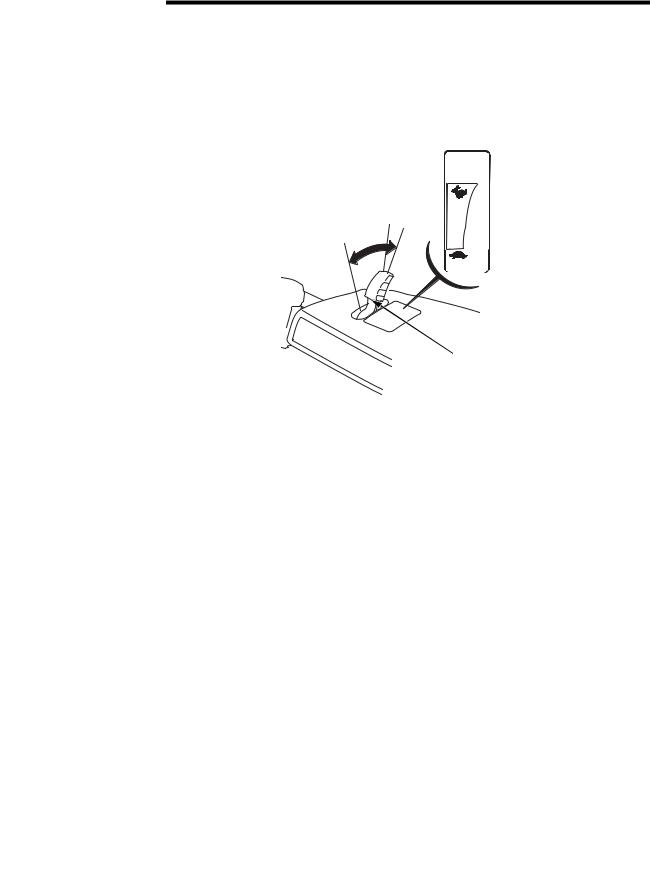
CONTROLS & FEATURES
Throttle Lever
The throttle lever controls engine speed from SLOW to FAST to CHOKE, it will stay in any designated position.
NOTE: For best snow blowing performance, keep the throttle lever in the FAST position.
FASTF ST
FAST CHOKE
SLOW
SLOWOW
THROTTLE LEVER
16

CONTROLS & FEATURES
Shift Lever
Forward and reverse directions can be selected by shifting this lever; it will also remain in any designated position. Actual movement of the snow blower will take effect when the drive clutch lever is engaged.
Set the lever in ‘‘N’’ (Neutral) when the snow blower is not in use.
FORWARD |
‘‘N’’ (Neutral) |
FORWARD |
|
||
|
|
|
|
REVERSE |
|
FAST
SLOW
NEUTRAL
SLOW
FAST
REVERSE |
SHIFT |
|
LEVER |
Chute joystick control
Use the joystick control to turn the snow discharge chute right or left and up or down.
The engine must be running to operate the chute joystick control. Chute movement speed will increase with engine speed. For maximum speed, move the throttle to the fastest position when using the chute joystick.
|
|
DOWN |
|
LEFT |
RIGHT |
|
DOWN |
|
|
RIGHT |
|
CHUTE JOYSTICK |
|
UP |
CONTROL |
LEFT |
|
|
UP |
|
17
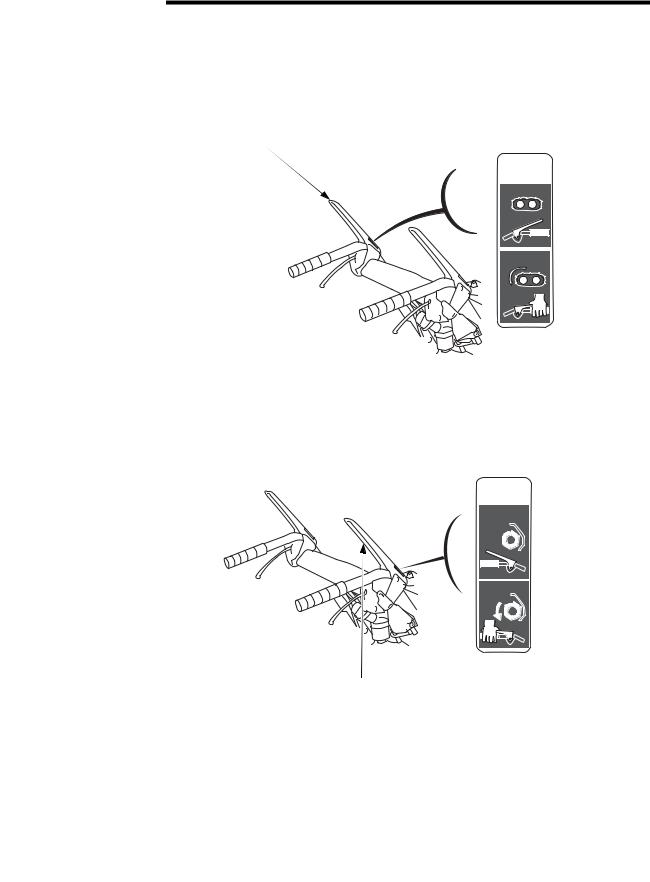
CONTROLS & FEATURES
Drive clutch lever
Depress the drive clutch lever to move the snow blower forward or backward based on the position of the shift lever (see previous page). If the snow blower is to be transported, depress the drive clutch lever without the auger clutch lever.
DRIVE CLUTCH
LEVER
DRIVE
CLUTCH
DISENGAGE
DISENGAGED
ENGAGE
ENGAGED
Auger clutch lever
Depress the auger clutch lever to start the snow blowing mechanism. If the drive clutch lever is engaged, the auger clutch lever will lock engaged when it is depressed. However, the auger clutch lever will unlock when the drive clutch lever is released.
AUGER
CLUTCH
DISENGAGE
DISENGAGED
ENGAGE
ENGAGED
AUGER CLUTCH LEVER
18
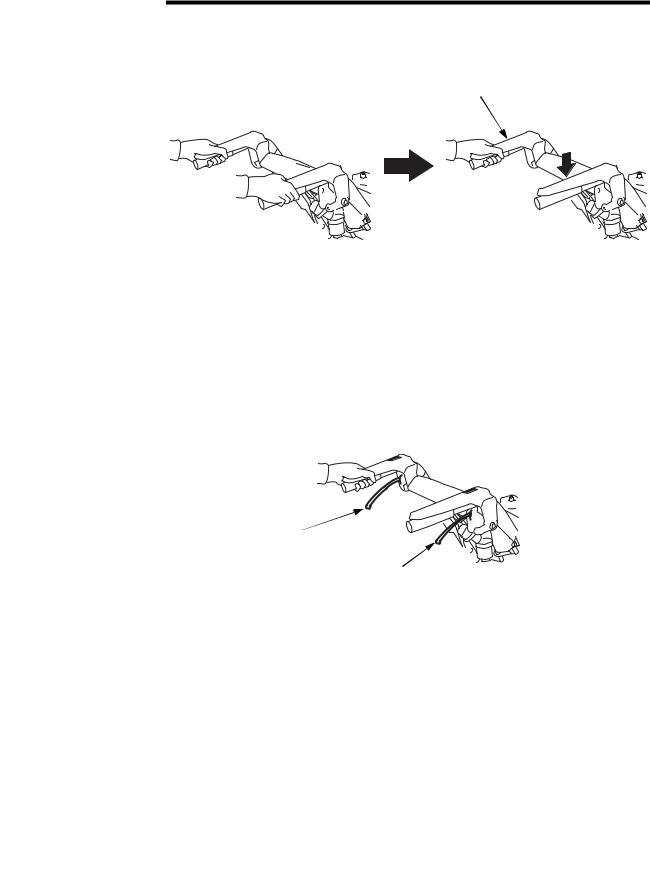
CONTROLS & FEATURES
When both levers are depressed, the drive clutch lever locks the auger clutch lever down. Releasing the drive clutch lever then unlocks and releases the auger clutch lever.
DRIVE CLUTCH LEVER
LOCKED
Both levers depressed
The auger clutch lever remains locked down as long as one hand continues to depress the drive clutch lever.
Steering controls
When both steering control levers are released, the snow blower will advance in a straight line in either a forward or reverse direction depending on the position of the shift lever.
LEFT STEERING
CONTROL LEVER
RIGHT STEERING
CONTROL LEVER
19

CONTROLS & FEATURES
Pull the left steering control lever against the handlebar to turn the snow blower to the left.
LEFT TURN
Pull the right steering control lever against the handlebar to turn the snow blower to the right.
RIGHT TURN
NOTE:
Do not partially engage or release the steering control levers. Always fully engage or fully release the levers.
Pull both steering control levers at the same time to momentarily disengage the transmission. With the transmission disengaged, the snow blower is free to maneuver (push or pull) by hand with or without the engine running.
20

CONTROLS & FEATURES
Height adjust lever (AT, ATD)
Use the infinitely variable height adjust lever to change the height of the auger housing.
1)Hold the handlebar with both hands and depress the lever with your left thumb.
2)Move the handle up or down as needed to obtain the desired auger height position.
3)Release the lever to lock the height of the auger in position.
(1)LOWER: Hard snow or fine finish
(2)MIDDLE: Normal use
(3)HIGHER: Deep snow or for transporting the snow thrower.
|
HIGH |
HEIGHT ADJUST LEVER |
LOW |
|
Do not pull on the gas assisted damper or tie it with a rope, or it may cause functional damage of the assembly.
21

CONTROLS & FEATURES
FEATURES
LED Work Light
LED WORK LIGHT
The light comes ON while the engine is running, and it goes OFF when the engine stops. The light does not come ON when the engine switch is turned ON unless the engine is started.
Snow Clearing Bar
If the snow discharge chute or |
|
snow blowing mechanism |
|
becomes restricted, stop the |
|
engine, and make sure all rotating |
|
parts have come to a complete |
|
stop. Remove the spark plug cap |
SNOW CLEARING BAR |
from the spark plug. |
|
Use the snow clearing bar to remove the obstruction.
An obstructed auger or blower could suddenly move when the obstruction is cleared.
Sudden auger or blower movement will cause severe injury if your hands are being used to clear the area.
Never clear the discharge chute or auger area with your hands, and always stop the engine, remove the spark plug cap, and clear obstructions with the clearing bar.
After clearing the obstruction, wipe the bar clean, and store it in the holders. Replace the spark plug cap.
22
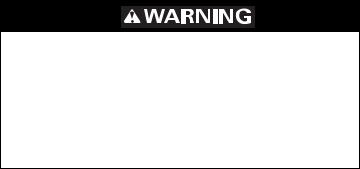
BEFORE OPERATION
ARE YOU READY TO GET STARTED?
Your safety is your responsibility. A little time spent in preparation will significantly reduce the risk of injury.
Knowledge
Read and understand this manual. Know what the controls do and how to operate them.
Familiarize yourself with the snow blower and its operation before you begin using it. Know how to quickly shut off the snow blower in case of an emergency.
IS YOUR SNOW BLOWER READY TO GO?
For your safety, and to maximize the service life of your equipment, it is very important to take a few moments before you operate the snow blower to check its condition. Be sure to take care of any problem you find, or have your servicing dealer correct it, before you operate the snow blower.
Improperly maintaining this snow blower, or failing to correct a problem before operation, could cause a significant malfunction.
Some malfunctions can seriously hurt or kill you.
Always perform a pre-operation inspection before each operation, and correct any problem.
Before beginning your pre-operation checks, be sure the snow blower is on a level surface and the engine switch is in the OFF position.
23

BEFORE OPERATION
Check the General Condition of the Snow blower:
•Before each use, look around and underneath the snow blower for signs of oil or gasoline leaks.
•Check the auger housing and the discharge chute for accumulation of packed snow or ice. Clean the auger housing and discharge chute before starting the snow blower.
•Look for signs of damage.
•Check each control for proper operation.
•Check the auger and blower for loose or broken bolts. If broken, replace them with new ones.
•Check the skid shoes and scraper for wear. Replace them if necessary (see page 52).
•Check that all nuts, bolts, and screws are tightened.
Check the Engine
•Check the oil level (see page 44).
•Check the fuel level (see page 42). Starting with a full tank will help to eliminate or reduce operating interruptions for refueling.
24

BEFORE OPERATION
CHECK YOUR WORK AREA
For your safety and the safety of others, always inspect the area before operating the snow blower.
Objects
Anything that can be picked up by the augers and thrown is a potential hazard to you and others. Thoroughly inspect the area where the equipment is to be used and remove all doormats, newspapers, sleds, boards, wires, stones, and nails from the work area.
People and Pets
People and animals near the work area can move into your snow blower’s path or into a position where they could be struck by thrown objects. Clear the area of people, especially children, and pets. Their safety is your responsibility.
Work Area
Check the condition of the snow. Adjust your snow blower ground speed (not engine speed) and snow blowing swath accordingly.
Check the skid shoes for proper adjustment. Adjust the skid shoes to obtain the auger ground clearance for the type of surface the snow blower will be operated over (see page 52).
25
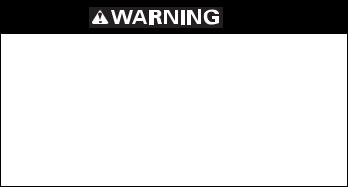
OPERATION
SNOW BLOWING PRECAUTIONS
Before operating the snow blower for the first time, please review both the SNOW BLOWER SAFETY chapter (see page 5) and the BEFORE OPERATION chapter (see page 23).
Even if you have operated other snow blowers, take time to become familiar with how this snow blower works, and practice in a safe area until you build up your skills.
Never tamper with or alter any of the controls or safety devices on the snow blower. Tampering is a violation of Federal and California law.
For your safety, do not start or operate the engine in an enclosed area such as a garage. Your snow blower’s exhaust contains poisonous carbon monoxide gas that can collect rapidly in an enclosed area and cause illness or death.
Exhaust contains poisonous carbon monoxide gas that can build up to dangerous levels in closed areas.
Breathing carbon monoxide can cause unconsciousness or death.
Never run the engine in a closed, or even partly closed area where people may be present.
26
